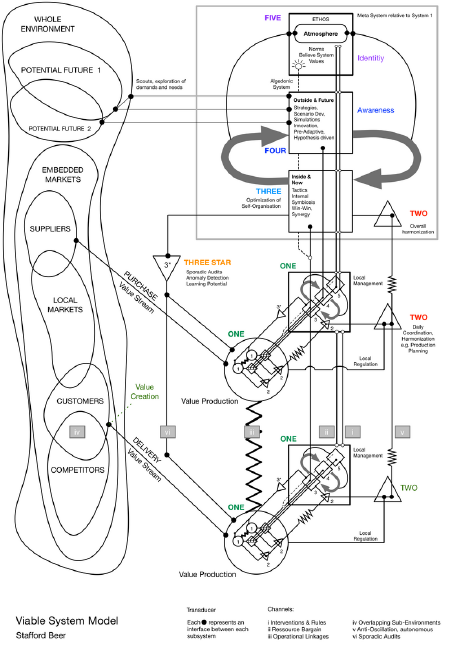Subterranean Homesick VSM
As people who know me will testify, I have a difficult relationship with the Viable Systems Model (VSM). This goes all the way back to when I was an undergraduate where I first encountered the VSM. My initial impression was that the VSM diagram (figure 1) as it was originally presented looks more like a wiring diagram than a way of communicating a system. Meeting, and taking part, in Stafford Beer’s research did nothing to convince me that the VSM was something to bring systems to the masses. It is worth noting that the model that is often utilised does not actually appear in “Brain of the Firm”.

Figure 1 Viable system model, Wikipedia
In the years that have followed I have encountered the VSM on a regular basis, often by systems experts, and in fact have used it within my current research. For the record, I think the VSM is a very useful tool that can assist in diagnosing or even designing a system, however my difficulty with the VSM is no longer that I think it’s inaccessible to the masses (thanks to evolutions in the diagram) but because it is often presented as a unitary approach and which is frequently causes confusion by being presented as a methodology and not a tool.
Wrongly identifying the VSM as a methodology is understandable, especially given that it is often taught in parallel to systems methodologies such as Systems Dynamics (SD), Soft Systems Methodology (SSM) and Critical Systems Heuristics (CSH). And to be fair to the people teaching the VSM they will usually highlight that Beer developed the model from the methodology of Cybernetics, although that is often then lost in the process of teaching people to use the VSM. But, and it’s a big but, Beer did not design the VSM to be a methodology but was very clear that it was intended to be a tool, stating “the model is intended for use as a diagnostic tool” (Beer, 1981, p.155).
Recognising that the VSM is a tool not a methodology is important, however it is also important to recognise that people can use a tool incredibly well and deliver significant results without understanding the methodology that underlies it. For instance, how many people use a hammer to build things without understanding any of the physics that underpin the effective use of the hammer? Whilst knowing the underlying methodology may help an individual (or an organisation) to maximise use of the tool, a lack of knowledge does not prevent the tool being utilised. When knowing the methodology becomes useful is when there is an understanding of multiple methodologies, and their associated tools, which leads to an informed choice being made into which is the best methodology or tool to use in a given situation of interest. For instance, whilst the VSM could be used in a politically or culturally sensitive situation, it may not be the most suitable or it may be more effective if utilised within a multi-methodological approach.
As a tool the VSM is extremely useful, in fact I would consider it as the “Swiss army knife” of systems tools as it is incredibly versatile. For instance, I have used it to help redesign a multi-million-pound organisation as well as using it to structure my PhD thesis. However, it does not really help to gain an understanding of the softer issues, and it certainly doesn’t help making decisions relating to the content of my thesis. But if I want to a quick and dirty way to document and understand a situation, then I would use an evolution of the VSM as a starting point, even if I then didn’t use it as a tool in the formal process of understanding, and maybe intervening, in a system of interest.
But when I do use the VSM, I always use an evolution of the model rather than the pure model introduced by Beer. For many years I had utilised by own evolution of the model but have recently come across an evolution developed by Deliberately Adaptive Organisation (DAO) created by Mike Burrows (figure 2).

What I absolutely love about what Mike has done, is that he has presented the VSM in a way which is accessible and utilises language that is easily understood. If you compare Mike’s diagram to Beer’s diagram, they share a lot of similarities but the version in DAO is a lot easier to relate to and doesn’t look complicated. Plus 3* in Beers original diagram looks more like an afterthought (which I’m sure wasn’t the intention and may be down to my perception) whereas in Mike’s it is given equal billing with the other elements of the model.
In terms of a simple and easy to access to the cybernetics side of the VSM, then my recommendation would be Second Order Cybernetics by Harish Jones, especially the chapter “Purpose of a System in Light of VSM”. But whilst I would always recommend exploring the methodologies behind the tools you use, I would ask you to first ask yourself the question, “will knowing the methodology lead me to being able to use the tool more effectively”? If the answer is yes, then delver as deep as you are comfortable with into the methodology, however if you are not open to changing you how you utilise the tool, then maybe your time would be better off refining your use of the tool.
References
- Beer, Stafford, 1981, Brain of the Firm
- Burrows, Mike, 2025, Wholehearted: Engaging withy Complexity in the Deliberately Adaptive Organisation
- Jone, Harish, 2025, Second Order Cybernetics
- Wikipedia, Viable system model, Wikipedia